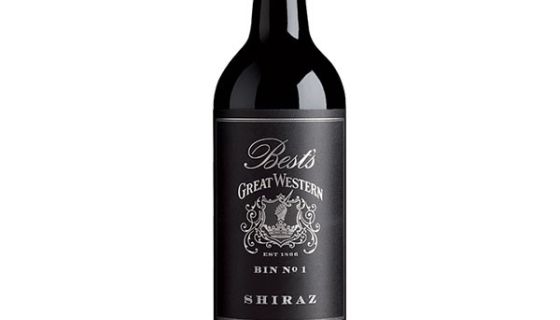From AU$20.99, $16.99, £15.99, CA$ 29.95, €19.37, 188 Hong Kong dollars, 28.50 Swiss francs
To many Australians of my generation, Great Western stirs memories of an inexpensive sparkling white wine of yesteryear (in our house it was mixed with orange juice on Christmas morning – and I’m sure we weren’t the only ones...). I’m ashamed to admit that until recently, I thought Great Western was the brand name for an inexpensive Australian fizz. But actually Great Western is an Australian GI (Geographic Indication – Australian for appellation), a tiny sub-region of the Grampians GI, one of the oldest quality wine-producing regions in Australia. What’s more, 90% of the plantings are Shiraz. A southern hemisphere Hermitage?
Recently I took my mum on a whistle-stop tour of western Victoria and was able to offset my ignorance by visiting Great Western. When out for an early morning walk I spotted this peeling billboard sponsoring the local football team, and wondered hopefully if a lack of investment in marketing might partly justify my ignorance. (It turns out that there is a long history of wrangling over the name Great Western between the two oldest producers; sparkling behemoth Seppelt and still-wine producer Best's).

Best's of Great Western have some of the oldest vines in Australia, and have remained family-owned (founded in 1866 by the Best family and then bought by the Thomson family in 1920), unlike Seppelt (whose $10 Fleur de Lys is apparently the sparkling wine of my memory). Seppelt was bought by Southcorp which was eventually absorbed into the massive Treasury Wine Estates.
Best’s cellar door is positively dripping in history and is well worth a visit – set as it is in the original stable building, with the 1860 cellars (dug by hand by out-of-work miners after the gold rush) still intact and surrounded by gnarly 150-year-old dry-farmed vines, on soils dominated by granite, quartz and clay.
Best’s produces around 25,000 cases of wine a year – of which roughly 8,000–10,000 are their entry-level Bin No 1 Shiraz. They also produce highly regarded premium Shirazes and a gorgeous old-vine Dolcetto that is much admired by our Walter, among other wines.
The grapes for the Bin No 1 Shiraz are a blend from two of Best’s own vineyards, Concongella and Salvation Gully, and bought-in grapes from trusted growers in the region. Bought-in fruit can make up anywhere between 20% to 50% of the blend in any given vintage, depending on quality. Wines are matured in predominantly old French oak, in a variety of barrel sizes, for 10-12 months.
Winemaker Justin Purser says their ambition for the Bin No 1 Shiraz is to produce a ‘benchmark example of easy-to-drink Great Western Shiraz’. I tasted the 2013, 2014, 2015 and 2016 vintages and they were certainly easy to drink. They will all age beautifully too, which is pretty impressive for a wine at this price. Although you could, thankfully, taste the vintage variation, what struck me was that they were remarkably consistent in terms of quality, no doubt due, at least in part, to the blending. This is a dependably delicious wine – and ridiculous value too. Even JR.com’s Max Allen has written in Australia's Gourmet Traveller WINE that he’d ‘pay more for it’.
The four vintages I tasted all had lovely plush, pure fruit but weren’t heavy or sweet. Savoury notes dominated all but the most recent vintage, with a mere hint of pepper on each finish. These are elegant, medium-bodied styles of Shiraz (I’m almost surprised they aren't labelled Syrah) which is down to the 'cool’ climate.
Great Western is considered a cool-climate wine region by Australian standards – hard to fathom when you’re standing there, as I was, on a sunny 26 °C (79 °F) autumn afternoon. In Great Western, it comes down to the diurnal range, or the difference between the day- and night-time temperatures. In this continental climate with cold winters and warm summers, it’s the all-important cool summer nights that extend the ripening season and allow more flavour development, while keeping the alcohol levels from skyrocketing and the acidity from plummeting.
Sitting at the base of an amphitheatre (walled in by the Grampians mountains to the west, the Black Range to the north and the Great Dividing Range to the south and east), the region is frost-prone too. Best’s 2017 vintage was severely shrunk by a black frost. The saying goes in Great Western that if you get through Melbourne Cup Day (the first Tuesday in November) without a frost, you’ll be OK. But this being Australia, drought and bushfires are also a risk. And English winemakers think they have it tough...
I’ve not specified a vintage for this wine of the week, in part because different vintages are available in each market. I tasted the 2016 at the cellar door in Australia, the 2015 is widely available in the US and UK, and once back in the UK I managed to get my hands on 2014 and 2013. The quality is so consistently good that, dare I say it, any vintage from the last ten years or so will be a winner.
Wine-searcher shows plenty of listings in Australia, the UK (where it is imported by Bibendum), the US, Canada, Hong Kong, Singapore and mainland Europe.














